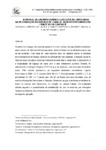Por favor, use este identificador para citar o enlazar este ítem:
http://www.alice.cnptia.embrapa.br/alice/handle/doc/916954| Título: | Atividade de enzimas ligninocelulolíticas envolvidas na degradação do bagaço de cana-de-açúcar por linhagens fúngicas da Caatinga. |
| Autor: | FERREIRA JUNIOR, O. L.  VILELA, E. S. D.   GIOVEDY, J. S.   SILVA, C. M. M. de S.   MELO, I. S. de   |
| Afiliación: | OSVALDO L. FERREIRA JÚNIOR, ETECAP; ELKE SIMONI DIAS VILELA, CNPMA; JONATHAN S. GIOVEDY, FAJ; CELIA MARIA MAGANHOTTO DE SOUZA SILVA, FAJ; ITAMAR SOARES DE MELO, CNPMA. |
| Año: | 2011 |
| Referencia: | In: CONGRESSO INTERINSTITUCIONAL DE INICIAÇÃO CIENTÍFICA, 5., 2011, Campinas. Anais... Campinas: Embrapa Monitoramento por Satélite, 2011. 1 CD ROM. |
| Páginas: | Nº 11419. |
| Descripción: | Resumo: Atualmente o bagaço de cana-de-açúcar é o maior resíduo da agroindústria brasileira, assim sendo, de alta importância que sejam desenvolvidas novas utilidades para o uso de tal substrato. Com esse fim, este trabalho teve por objetivo avaliar a atividade ligninocelulolítica de fungos isolados de serrapilheira da Caatinga. A seleção inicial foi feita em meio de cultivo contendo Remazol Brilliant Blue e observado o crescimento e a degradação de bagaço de cana com e sem tratamento químico. Destes, foi selecionada a linhagem fúngica 3.3 F2 na qual se observou uma atividade enzimática maior. Este isolado apresentou as seguintes atividades enzimáticas: Lignina Peroxidase (4,9046 U.L-1), Lacase (54,9148 U.L-1), Endoglucanase (4,4966 U.L-1), ?-glicosidase (5,1494 U.L-1) sendo que não foi verificada nenhuma atividade para as enzimas Manganês Peroxidase e Xilanase. Observou-se que a atividade enzimática foi maior no resíduo sem tratamento, em relação ao resíduo tratado. Os resultados obtidos sugerem a possibilidade da substituição do uso de enzimas, por linhagens fúngicas produtoras das mesmas para otimização do processo de produção de etanol de segunda geração. Abstract: Sugar cane bagasse nowadays is one of the biggest waste produced by Brazilian agroindustry, becoming relevant the development of new uses for it. The objective of this study was to evaluate the lignocellulolytic activity in sugar cane bagasse of fungi isolated from litter in Caatinga biome. Screening was performed on Petri dishes, where 4 isolates were selected for quantification of lignolytic enzyme by discoloration of Remazol Brilliant Blue, with growth observation and degradation of sugarcane bagasse with and without chemical treatment. From the fungal isolates, strain 3.3 F-2 showed increased activity and was selected for evaluation of lignocellulolytic enzymes. It showed the following enzymatic activities: LigninPeroxidase (4.9046 U.L-1), Laccase (54.9148 U.L 1), endoglucanase (4.4966 U.L-1), β-glucosidase (5.1494 U.L-1) and Manganese Peroxidase and Xylanase displayed no activity. The enzymes showed higher activity with the untreated material. These results suggest the possibility of replacing the use of enzymes for enzyme-producing fungal strains to optimize the process of ethanol production. |
| Thesagro: | Enzima celulolítica Bagaço Biodegradação Caatinga |
| NAL Thesaurus: | Cellulolytic microorganisms Sugarcane bagasse Biodegradation |
| Palabras clave: | Cana-de-açúcar |
| Tipo de Material: | Artigo em anais e proceedings |
| Acceso: | openAccess |
| Aparece en las colecciones: | Artigo em anais de congresso (CNPMA)  |
Ficheros en este ítem:
| Fichero | Descripción | Tamaño | Formato | |
|---|---|---|---|---|
| 2011AA45.pdf | 436,94 kB | Adobe PDF |  Visualizar/Abrir |









